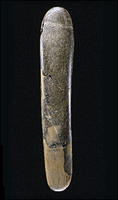Ancient phallus unearthed in cave
 A sculpted and polished phallus found in a German cave is among the earliest representations of male sexuality ever uncovered, researchers say.
A sculpted and polished phallus found in a German cave is among the earliest representations of male sexuality ever uncovered, researchers say.The 20cm-long, 3cm-wide stone object, which is dated to be about 28,000 years old, was buried in the famous Hohle Fels Cave near Ulm in the Swabian Jura.
The prehistoric "tool" was reassembled from 14 fragments of siltstone.
Its life size suggests it may well have been used as a sex aid by its Ice Age makers, scientists report.
"In addition to being a symbolic representation of male genitalia, it was also at times used for knapping flints," explained Professor Nicholas Conard, from the department of Early Prehistory and Quaternary Ecology, at Tübingen University.
"There are some areas where it has some very typical scars from that," he told the BBC News website.
Researchers believe the object's distinctive form and etched rings around one end mean there can be little doubt as to its symbolic nature.
--

0 Comments:
Post a Comment
<< Home